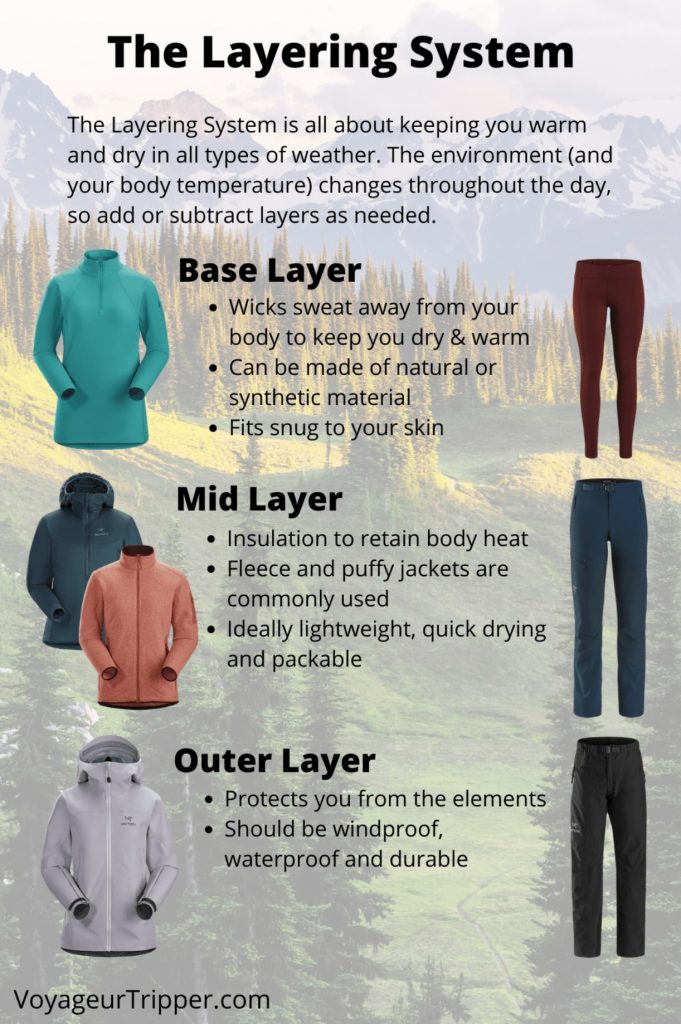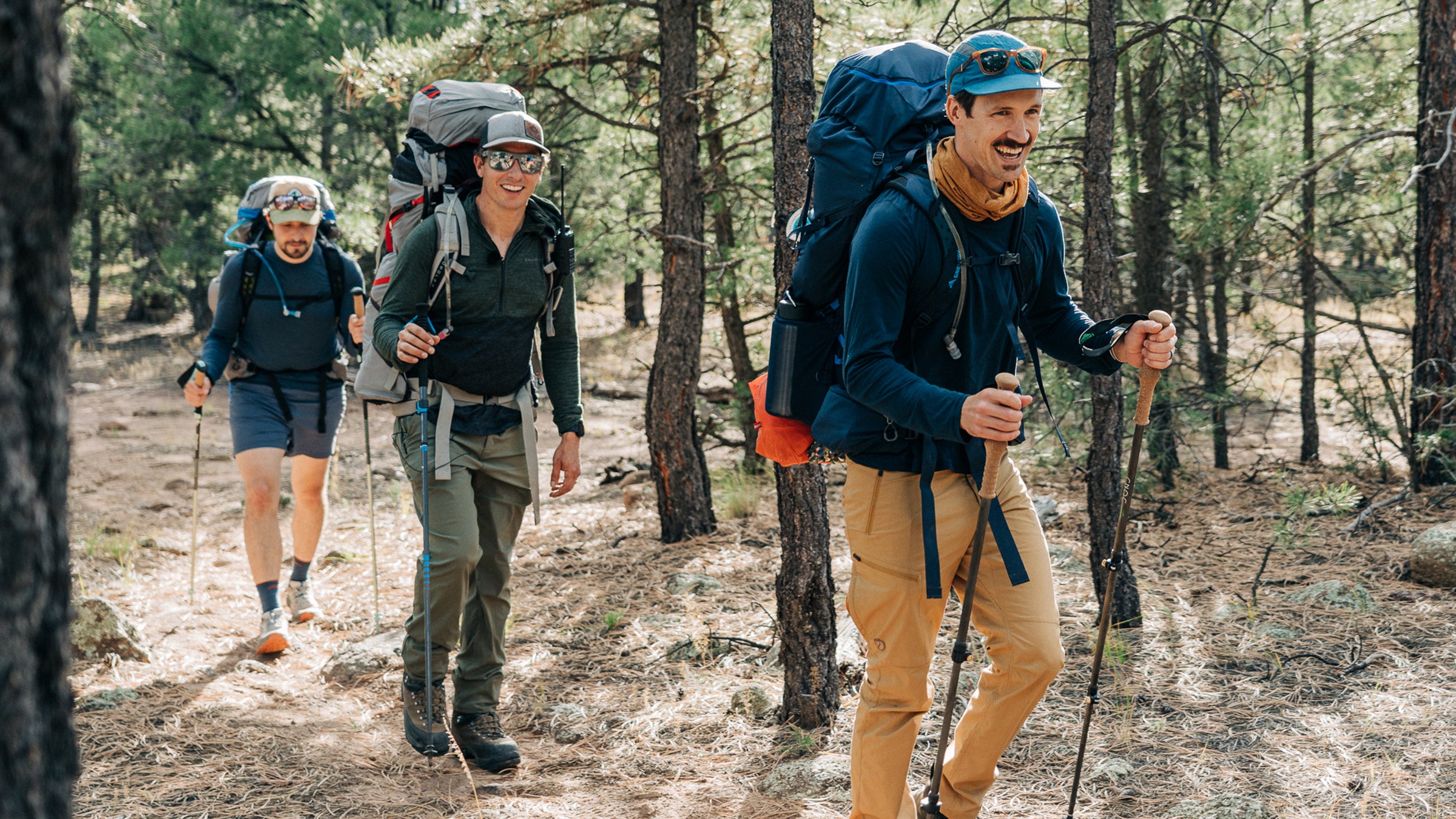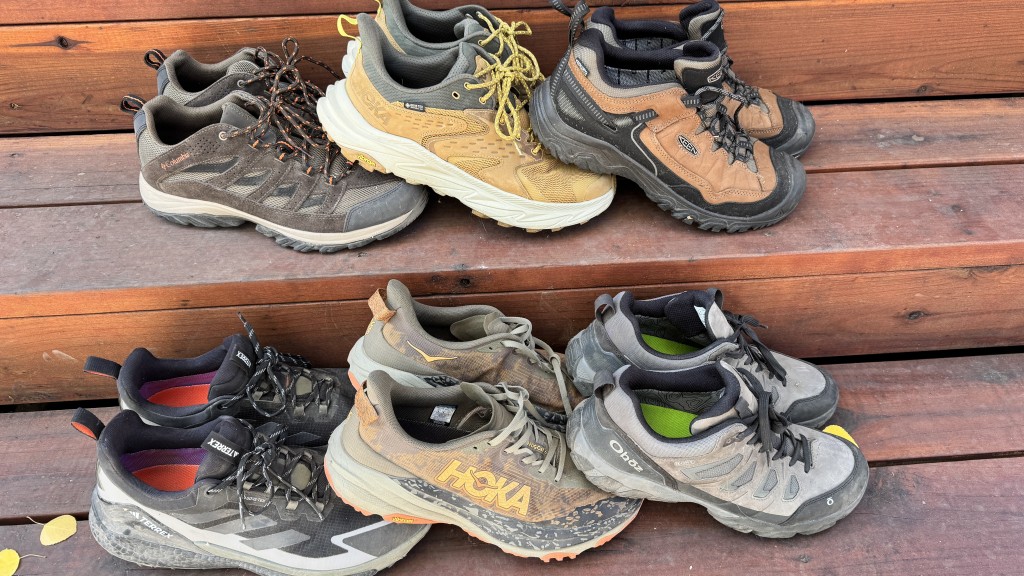The Ultimate Guide to Hiking Clothes for Men: Expert-Tested Gear for Every Adventure
After 15+ years of hiking through diverse terrains—from the scorching deserts of Arizona to the alpine meadows of the Rockies—I've learned that the right hiking clothes for men can make or break your outdoor experience. Whether you're planning your first day hike or preparing for multi-day backcountry adventures, this comprehensive guide covers everything you need to know about men's hiking apparel. Explore National Parks Store has been my go-to resource for quality outdoor gear recommendations.
The Essential Three-Layer System

Understanding proper layering is crucial for any serious hiker. The three-layer system has saved me countless times during unexpected weather changes in places like Glacier National Park and the Grand Canyon. This system allows you to adapt to changing conditions by adding or removing layers as needed.
Base Layer: Moisture Management
Your base layer is responsible for wicking moisture away from your skin. I learned this lesson the hard way during a soggy hike in Olympic National Park when my cotton t-shirt left me cold and clammy. Quality merino wool hiking clothes or synthetic materials are essential here.
Mid Layer: Insulation
The mid layer provides warmth through insulation. Fleece jackets, down vests, or synthetic insulation work well. This layer traps warm air while allowing moisture to pass through to the outer layer.
Outer Layer: Weather Protection
Your shell layer protects against wind, rain, and snow. A quality rain jacket or softshell provides the final barrier against the elements. I always carry one, even on sunny days—mountain weather changes fast.
Base Layers: Your Foundation

The foundation of any good hiking outfit starts with your base layer. During my early hiking days, I made the mistake of wearing cotton, which left me uncomfortable and potentially dangerous in changing weather. Now, I exclusively use moisture-wicking materials that keep me dry and comfortable.
Material Choices for Hiking Clothes for Men
Merino Wool: My personal favorite for most conditions. It naturally regulates temperature, resists odors, and remains comfortable even when damp. Perfect for multi-day hikes where washing isn't possible.
Synthetic Materials: Polyester and nylon blends dry faster than wool and are typically more durable. Great for high-sweat activities and humid conditions.
Avoid Cotton: "Cotton kills" isn't just a saying—it retains moisture, loses insulation when wet, and can lead to hypothermia. I learned this during a rainy hike in the Cascades where cotton socks gave me painful blisters.
For summer hiking clothes, I prefer lightweight, long-sleeved base layers with UPF protection. They provide sun protection while still allowing airflow—crucial during desert hikes in places like Joshua Tree.
Hiking Pants and Shorts Guide
Choosing the right lower body gear depends on your hiking environment and personal preferences. Over the years, I've tested everything from lightweight running shorts to heavy-duty mountaineering pants across various terrains and weather conditions.
Convertible Pants: The Versatile Choice
Convertible pants with zip-off legs are my go-to for variable weather. I can start cool mornings as pants and convert to shorts when temperatures rise. Essential for hikes like the Grand Canyon where you start in cool rim conditions and descend to desert heat.
My current favorite is the REI Co-op Sahara Convertible Pants, which I've put through hundreds of miles without significant wear. They're featured in my recommendations for best hiking clothes for men.
Hiking Shorts: Warm Weather Champions
For hot weather hiking, I prefer shorts with 5-7 inch inseams made from quick-dry materials. Look for features like secure zip pockets, gusseted crotches for mobility, and UPF sun protection.
During summer hikes in Arizona, proper cool hiking clothes make the difference between an enjoyable experience and a miserable slog.
User Review Summary
Amazon Customer Review (4.4/5 stars): "These convertible pants are perfect for day hikes. The zip-off legs are secure and the fabric dries quickly. Used them on a 10-mile hike in variable weather—started as pants in the morning chill and finished as shorts in the afternoon heat. Highly recommended for versatility." - Mike D., verified purchase
Reddit r/hiking feedback: "Bought these based on trail recommendations. Three months in, they've held up to bushwhacking, rock scrambling, and multiple washes. The reinforced knees are a nice touch. Worth the investment over cheap alternatives." - u/TrailRunner85
REI Customer Review: "As a frequent day hiker, these are my go-to pants. The fit is comfortable with a pack, and the quick-dry feature saved me during an unexpected creek crossing. The only downside is they're not great for cold weather hiking." - Sarah L., Co-op member
Footwear and Sock Essentials

Your feet are your most important tools on the trail, and proper footwear can prevent injuries and enhance your hiking experience. I've learned through painful experience (literally) that cheap socks and ill-fitting boots can ruin even the shortest hikes.
The Sock Revolution
Quality hiking socks were a game-changer for me. After getting blisters on a Sierra Nevada backpacking trip, I invested in merino wool socks with proper cushioning. The difference was immediate—no more hot spots or moisture buildup.
Look for socks with:
- Merino wool or synthetic moisture-wicking materials
- Cushioning in heel and forefoot areas
- Seamless toe construction
- Height that works with your boots (crew or boot height)
For winter hiking clothes, I use thicker wool socks with additional insulation properties.
Hiking boots versus trail shoes is an ongoing debate, but I've found that trail shoes work for 80% of my hiking. They're lighter, dry faster, and more comfortable for long distances. I only switch to boots for heavy pack loads or technical terrain with loose rock.
Seasonal Clothing Strategies
Adapting your clothing system to seasonal conditions is crucial for comfort and safety. Each season presents unique challenges that I've encountered across different climate zones and elevations.
🌞 Summer Strategies
Summer hiking requires balancing sun protection with heat management. I learned this during desert hikes where UV exposure can be dangerous even in "mild" 85°F weather.
- Long-sleeve shirts with UPF 50+ rating
- Lightweight, light-colored fabrics
- Wide-brimmed sun hat
- Quick-dry shorts or convertible pants
🍂 Fall Adaptability
Fall weather is unpredictable. During a Colorado hike, I started in shorts and ended in full rain gear with temperatures dropping 30 degrees.
- Layer-friendly clothing systems
- Waterproof outer shell always packed
- Insulating mid-layers ready
- Extended-coverage base layers
❄️ Winter Essentials
Winter hiking demands serious preparation. Hypothermia is a real threat, as I experienced during an early season Cascade Range hike.
- Insulated base layers (wool or synthetic)
- Down or synthetic insulation layers
- Waterproof/breathable shell systems
- Insulated, waterproof boots
🌸 Spring Preparation
Spring conditions can change rapidly. Muddy trails, stream crossings, and variable weather require versatile clothing choices.
- Quick-dry materials for muddy conditions
- Gaiters for debris protection
- Waterproof layers for spring storms
- Insect protection for emerging bugs
For those looking for budget-friendly options, check out cheap hiking clothes that still meet safety and comfort standards. You don't need to spend a fortune to stay comfortable on the trail.
My Personal Gear Evolution
My Hiking Background: Over 15 years of hiking experience across 30+ national parks, from sea-level coastal trails to 14,000+ foot peaks. I've made plenty of mistakes so you don't have to.
Early Mistakes and Hard Lessons
My first major hiking mistake was wearing jeans and cotton t-shirts on a Mount Washington hike. When weather changed unexpectedly, I became hypothermic and had to turn back. That experience taught me the importance of proper hiking clothes for men and weather preparedness.
Current Go-To System
After years of testing, my current system centers around versatility and proven performance. For most three-season hiking, I use convertible pants, merino wool base layers, and a trusty rain shell. This combination has served me well from the humid trails of Great Smoky Mountains to the alpine environments of Rocky Mountain National Park.
Gear That's Earned My Trust
Base Layer: Smartwool Merino 150 - odor-resistant and comfortable for multi-day trips
Pants: REI Co-op Sahara Convertible - 5+ years of regular use with minimal wear
Rain Shell: Patagonia Torrentshell - lightweight, packable, and reliable in Pacific Northwest downpours
Footwear: Altra Lone Peak shoes - zero-drop design improved my hiking comfort significantly
Seasonal Adaptations from Experience
Living in Colorado has taught me about rapid elevation and weather changes. I've learned to always pack additional layers, even for "easy" summer hikes. My system now includes quick-access layers that I can put on without removing my pack—crucial for maintaining warmth during brief stops.
For hikers interested in complete seasonal strategies, my guides on outdoor hiking clothes cover specific recommendations for different environments and conditions.
Essential Shopping Considerations
When building your hiking wardrobe, prioritize quality over quantity. I've learned that a few high-quality pieces that work well together are better than a closet full of mediocre gear.
✅ Pros of Quality Hiking Clothes
- Durability saves money long-term
- Better moisture management and comfort
- Advanced features like UPF protection
- Improved fit reduces chafing and hot spots
- Often better warranty and customer service
❌ Cons to Consider
- Higher upfront investment required
- May be overkill for occasional hikers
- Can be tempting to over-buy gear
- Some premium features aren't always necessary
- Brand markups on certain items
For those just starting out, I recommend checking hiking clothes sale sections first. Many quality brands offer excellent deals on previous season colors and styles.
If you're looking for local options, search for hiking clothes near me to try on gear before purchasing. Proper fit is crucial, especially for base layers and footwear.
Frequently Asked Questions
What are the essential clothing items every male hiker needs?
Essential hiking clothes for men include moisture-wicking base layers, insulating mid-layers, waterproof outer shell, quick-dry hiking pants or shorts, merino wool socks, and proper hiking boots. A sun hat and UV-protective long-sleeve shirt are also crucial for sun protection. Start with these basics and add specialized items based on your specific hiking conditions and frequency. Quality base layers and socks make the biggest difference in comfort, so prioritize these items in your budget.
How do I choose the right fabric for hiking clothes?
Choose synthetic fabrics like polyester or nylon for quick-drying and durability, or merino wool for natural odor resistance and temperature regulation. Avoid cotton as it retains moisture and loses insulation when wet, which can be dangerous in changing weather conditions. Look for fabrics with UPF ratings for sun protection, especially for shirts and hats. Blended fabrics often offer the best combination of comfort, durability, and performance. Consider your hiking environment—synthetics excel in humid conditions while wool performs better in cold, dry climates.
What's the difference between hiking clothes and regular workout clothes?
Hiking clothes are designed for extended outdoor use with features like reinforced areas for pack wear, UPF sun protection, insect repellent treatments, and materials that handle varying weather conditions. They typically offer better durability and weather resistance than regular workout clothes. Hiking-specific garments also include features like secure zip pockets, longer cut backs for pack compatibility, and strategic ventilation. While workout clothes focus on gym environments, hiking clothes must handle brush, rocks, UV exposure, and rapid weather changes. The construction is typically more robust to handle outdoor abrasion and washing frequency.
How many layers should I wear when hiking?
Use the three-layer system: base layer for moisture-wicking, mid-layer for insulation, and outer layer for weather protection. Adjust layers based on activity level, weather, and temperature. Start with fewer layers and add as needed to avoid overheating, which can be dangerous due to increased sweat production. The key is having the right layers available rather than wearing them all at once. Most day hikes require only 1-2 layers, but carrying a third layer provides safety margin. In winter conditions, all three layers plus accessories like hats and gloves become essential for safety and comfort.
Should I buy expensive hiking clothes or budget alternatives?
Invest in quality for items you rely on most: base layers, socks, and outer shells. Budget alternatives work well for occasional hikers, but frequent hikers benefit from premium materials' durability, comfort, and performance features. Start with basics and upgrade based on your hiking frequency and conditions. Quality base layers and socks prevent blisters and discomfort, making them worth the investment. Outer shells protect against dangerous weather, so reliability is crucial. Mid-layers and pants can often be found at good value without sacrificing performance. Consider cost-per-use rather than initial price when making decisions.
Conclusion
Selecting the right hiking clothes for men is an investment in both safety and enjoyment on the trail. After thousands of miles across diverse terrains and weather conditions, I can confidently say that proper clothing makes the difference between memorable adventures and miserable experiences.
The three-layer system, quality base layers, and appropriate seasonal adaptations form the foundation of any good hiking wardrobe. Remember that the best gear is what works for your specific hiking style, local conditions, and budget constraints.
Start with essential items like moisture-wicking base layers and quality socks, then build your system based on experience. Whether you're exploring local trails or planning backcountry adventures, the right clothing will help you stay comfortable, safe, and focused on the incredible landscapes waiting to be discovered.
Ready to upgrade your hiking wardrobe?
Explore More Hiking Guides